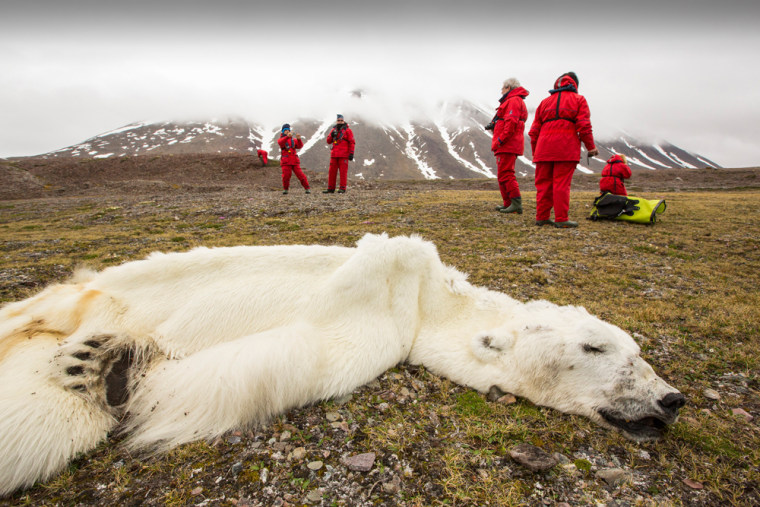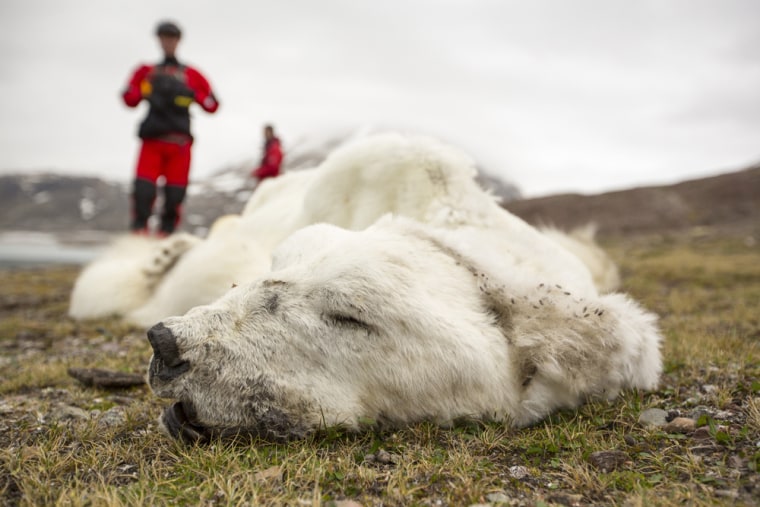
The polar bear’s emaciated body looked more like “a rug” than one of the world’s most powerful predators.
For all its hunting prowess, the giant animal appears to have starved to death as it made a desperate journey north on the Arctic island of Svalbard in search of seals.
Experts fear polar bears will increasingly suffer a similar fate as global warming melts the sea ice that allows them to hunt for their main source of food.
Ian Stirling, who has studied polar bears for nearly 40 years, told The Guardian newspaper that he found the animal on Svalbard in July.
“From his lying position in death the bear appears to simply have starved and died where he dropped,” Stirling said. “He had no external suggestion of any remaining fat, having been reduced to little more than skin and bone.”
The bear was examined by Norwegian scientists in April about 150 miles south and seemed to be healthy at that time.
“Most of the fjords and inter-island channels in Svalbard did not freeze normally last winter and so many potential areas known to that bear for hunting seals in spring do not appear to have been as productive as in a normal winter,” said Stirling, of conservation group Polar Bears International. “As a result the bear likely went looking for food in another area but appears to have been unsuccessful.”

A study published in July found that the Arctic could be essentially free of sea ice in September as early as 2054.
Polar Bears International says on its website that the bears evolved for a life on sea ice, "which they rely on for reaching their seal prey." The loss of sea ice has meant an increase in drownings and cannibalism, and a general decline in population.
Ashley Cooper, the photographer who took the picture, said the sight of the dead polar bear was “desperately sad.”
“There was just no fat on it. It was just completely shrunken and shriveled, a very, very skinny specimen of a polar bear,” he said in a telephone interview. “It looked basically like a rug because there was just no weight on it at all.”
Cooper said scavengers had not eaten parts of the body and there were no signs of decomposition, which happens slowly in the low temperatures of the Arctic.
He said he saw five live polar bears during a 12-day trip to Svalbard in July. Three looked “quite thin and not in great condition” and the only one that looked healthy was hunting on sea ice barely strong enough to support its weight about 550 miles from the North Pole.
Cooper said the fate of the bear was “what [all] polar bears have got to look forward to over the next 10 to 20 years.”
“There isn’t a future for them unless we can very rapidly get on top of climate change,” he said.
Jeff Flocken, at the International Fund for Animal Welfare, told The Guardian it was difficult to blame climate change for a single death.
But he added “it couldn't be clearer that drastic and long-term changes in their Arctic habitat threaten the survival of the polar bear.”
“The threat of habitat loss from climate change, exacerbated by unsustainable killing for commercial trade in Canada, could lead to the demise of one of the world's most iconic animals, and this would be a true tragedy.”
Related: